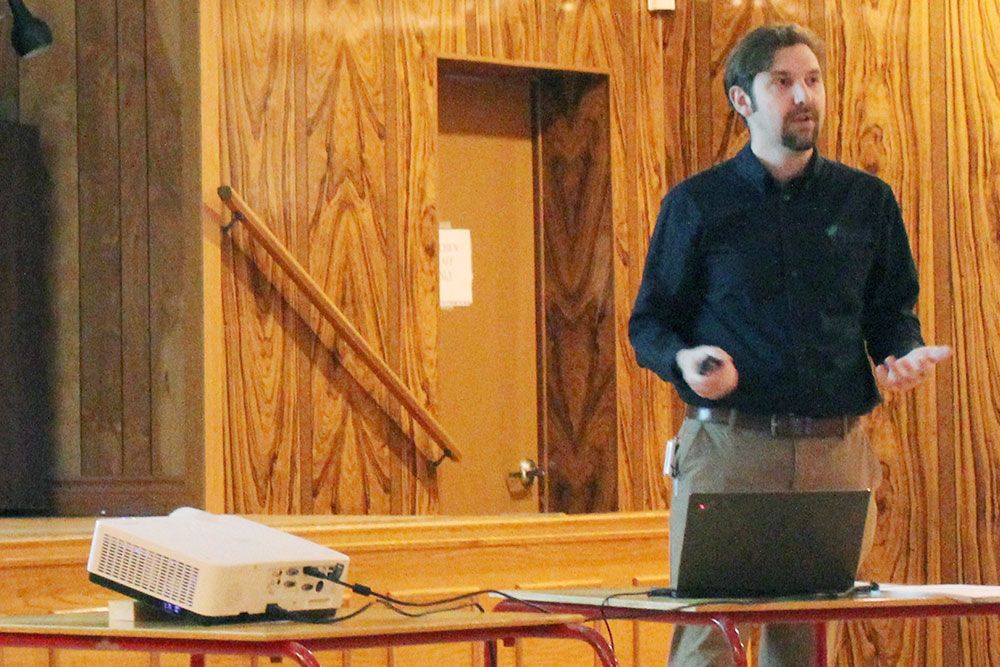Flood meeting draws more than 30

Community Emergency Management Coordinators among more than 30 participants at annual Flood Emergency Planning Meeting in Exeter
Ausable Bayfield Conservation Authority (ABCA) hosted its annual Flood Emergency Planning Meeting on March 5, 2024. The flood emergency planning meeting was held at the Royal Canadian Legion Hall, RE Pooley Branch 167, on William Street, Exeter. This was the first time ABCA has hosted this meeting at that location.
More than 30 people attended. Those taking part included police officers; representatives of counties and municipalities (including municipal Community Emergency Management Coordinators); and local public health staff.
Marissa Vaughan, Chair of the ABCA Board of Directors, welcomed the attendees.
Davin Heinbuck, ABCA General Manager and Secretary-Treasurer, spoke about ABCA’s flood forecasting and warning program for municipalities. He spoke about roles and responsibilities of the Province of Ontario; municipalities; conservation authorities; and other agencies during flood events. He also spoke about watershed conditions and the current flood outlook. He provided examples of local flooding over the years. He explained how ABCA protects life and property through programs that manage natural hazards such as flooding and erosion.
Historically, some of the worst flooding in the watershed has been during a spring freshet, when warming weather, rain, and melting snow combine to cause flooding. “Those types of events now, when they do happen, seem to be happening more often in January and February,” Davin said. “The traditional flooding periods … are basically year-round now. Flooding does happen and it happens throughout the year.”
The risk of flooding, around the time of the meeting, was low, as there was little or no snow on the ground, which is unusual for early March. There has not been a major flooding event this year but Davin cautioned that “ … flooding can happen at any time.” Some areas of the watershed are more flood-prone than others but “ … just as flooding can happen at any time it can also happen anywhere.”
Daniel King, Water Resources Engineer, presented to the meeting about river watch monitoring and about ice jams and river ice breakup.
The monitoring of ice presence and thickness, and the potential for ice break-up, is a component of the flood forecasting and warning program. This part of the program is especially challenging, King said, given the unpredictability of ice formation and breakup. Forecasting ice-jam events is still an ongoing area of study, which is why ABCA relies on staff observations for this component of their flood forecasting and warning work.
In addition to monitoring ice in watercourses, ABCA staff collect data in the field with ‘boots on the ground’ and ‘eyes on the ground’ through river watch monitoring and by measuring, in the field, the extent of the snowpack and the snow water equivalent.
They also monitor real-time weather conditions and incorporate weather forecasting into their models. The combination of all these data streams, along with the operation and calibration of ABCA’s flood modeling, allows the conservation authority to provide important and timely information to municipalities, especially those that may be downstream, leading up to and during a flood event.
Tim Cumming, Communications Specialist, explained the levels of flood messages. Flood messages include Watershed Conditions Statements (Flood Outlook and Water Safety); and Shoreline Conditions Statements (for flooding and erosion).
The more serious levels of flood messages are Flood Watches; and Flood Warnings. A ‘flood watch’ has the ingredients that make a flood event possible and the ‘flood warning’ indicates the ingredients are mixed together and are imminent or occurring.
To learn more visit the flood messages page.